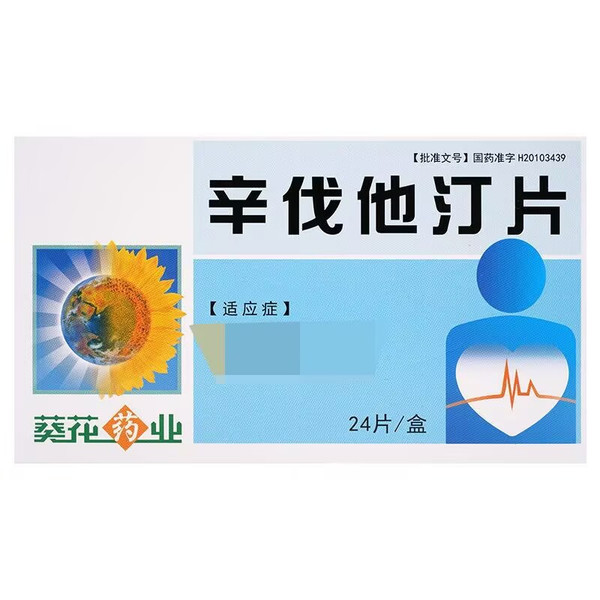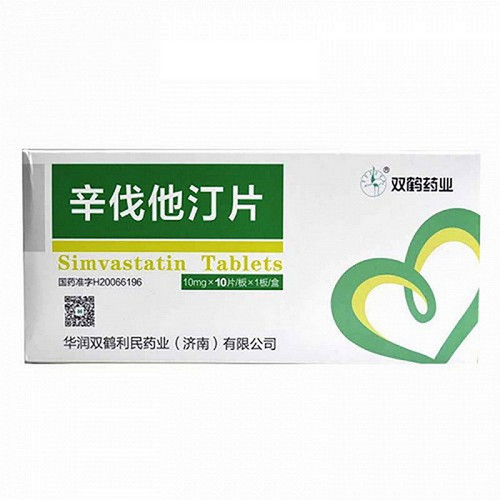Product Overview
[Drug Name]
Generic Name: Simvastatin Tablets
Trade Name: Sunflower Simvastatin Tablets 10mg*24 Tablets
[Main Ingredients]
Simvastatin.
[Indications/Main Functions]
1. Hyperlipidemia: (1) For patients with primary hypercholesterolemia, heterozygous familial hypercholesterolemia or mixed hypercholesterolemia, when dietary control and other non-drug treatments are not ideal, simvastatin can be used to reduce elevated total cholesterol, low-density lipoprotein cholesterol, apolipoprotein B and triglycerides. Simvastatin also increases high-density lipoprotein cholesterol, thereby reducing the ratio of low-density lipoprotein to high-density lipoprotein and total cholesterol to high-density lipoprotein. (2) For patients with homozygous familial hypercholesterolemia, when dietary control and non-dietary treatments are not ideal, simvastatin can be used to reduce elevated total cholesterol, low-density lipoprotein cholesterol and apolipoprotein B. 2. Coronary Heart Disease: (1) Reduce the risk of death. (2) Reduce the risk of death from coronary heart disease and non-fatal myocardial infarction. (3) Reduce the risk of stroke and transient ischemic attack. (4) Reduce the risk of myocardial revascularization surgery (coronary artery bypass grafting and percutaneous coronary angioplasty). (5) Delay the progression of atherosclerosis; including the occurrence of new lesions and complete blockage. 3. Children with heterozygous familial hypercholesterolemia. For adolescent boys and girls aged 10-17 years (at least 1 year after menarche) with heterozygous familial hypercholesterolemia, combined with diet control, this product can be used to lower total cholesterol, low-density lipoprotein cholesterol, apolipoprotein B and triglycerides.
[Specification]
10mg*24 tablets
[Usage and Dosage]
Oral, can be broken up and taken if necessary. 1. Hypercholesterolemia: The general starting dose is 10mg per day, taken in the evening. For patients with mild to moderately elevated cholesterol levels, the starting dose is 5mg per day. If the dose needs to be adjusted, it should be adjusted at least four weeks apart. The maximum dose is 40ng per day, taken in the evening. When LDL cholesterol levels drop to 75 mg/dL (1.94 mol/L) or total cholesterol levels drop below 140 mg/dL (3.6 mol/L), the simvastatin dose should be reduced. 2. Homozygous Familial Hypercholesterolemia: Based on controlled clinical studies, the recommended daily dose of simvastatin for patients with homozygous familial hypercholesterolemia is 40 mg/day taken in the evening, or 80 mg/day divided into three doses: 20 mg in the morning, 20 mg at noon, and 40 mg in the evening. Simvastatin should be used in combination with other lipid-lowering therapies (such as LDL aspiration). When these methods are unavailable, simvastatin can be used alone. 3. Coronary Artery Disease: Patients with coronary artery disease can take 20 mg daily in the evening as a starting dose. If dose adjustment is necessary, refer to the instructions above (Usage and Dosage for Hypercholesterolemia). 4. Concomitant Therapy: Simvastatin is effective both alone and in combination with bile acid sequestrants. For patients taking concomitant immunosuppressants, the recommended dose of simvastatin is 10 mg daily. 5. Renal Impairment: Because simvastatin is not significantly excreted by the kidneys, no dose adjustment is required for patients with moderate renal impairment. However, for patients with severe renal impairment (creatinine clearance less than 30 ml/min), the use of doses exceeding 10 mg daily should be carefully considered and used with caution.
[Adverse Reactions]
Simvastatin is generally well tolerated, with most adverse reactions being mild and transient. In controlled clinical trials, fewer than 2% of patients discontinued simvastatin due to adverse reactions. In controlled clinical trials, adverse reactions (classified as possibly, suspected, or definitely) attributed to drug-relatedness at an incidence greater than or equal to 1% included abdominal pain, constipation, and flatulence. Adverse reactions occurring in 0.5% to 0.9% of patients included fatigue, weakness, and headache. Reports of myopathy are rare. The following adverse reactions have been reported in uncontrolled clinical trials or postmarketing use: nausea, diarrhea, rash, dyspepsia, pruritus, alopecia, dizziness, muscle cramps, myalgia, pancreatitis, paresthesia, peripheral neuropathy, vomiting, anemia, rhabdomyolysis, and hepatitis/jaundice have rarely occurred. A frank hypersensitivity syndrome with one or more of the following features has been reported rarely: angioedema, lupus-like syndrome, polymyalgia rheumatica, vasculitis, thrombocytopenia, eosinophilia, increased erythrocyte sedimentation rate (ESR), arthritis, arthralgia, urticaria, photosensitivity, fever, flushing, dyspnea, and malaise. Laboratory findings: Significant and persistent elevations of serum aminotransferases have been reported rarely. Liver function test abnormalities have been mild or transient. Elevations of serum creatine phosphokinase (CK), derived from skeletal muscle, have also been reported.
[Contraindications]
1. Hypersensitivity to any component. 2. Active hepatitis or unexplained persistent elevations of serum aminotransferases. 3. Concomitant use with the tetralin calcium channel blocker mibefradil.
[Drug Interactions]
1. The risk of rhabdomyolysis is increased when simvastatin is used concomitantly with other drugs that significantly inhibit cytochrome P450 3A4 at therapeutic doses (e.g., cyclosporine, mibefradil, itraconazole, ketoconazole, erythromycin, clarithromycin, and nefazodone), or with fibric acid derivatives or niacin. 2. Concomitant use of simvastatin with methylhydroxyglutaryl coenzyme A (HMG-CoA) reductase inhibitors, including gemfibrozil and other fibrates, and lipid-lowering doses of niacin (≥1 g/day), may increase the incidence and severity of myopathy. Furthermore, elevated plasma levels of HMG-CoA reductase inhibitor activity may also increase the risk of myopathy. Simvastatin and other HMG-CoA reductase inhibitors are metabolized by the cytochrome P450 isoenzyme 3A4. Several drugs that significantly inhibit this metabolic pathway at therapeutic doses can increase HMG-CoA reductase inhibitor plasma levels and, therefore, increase the risk of myopathy. These drugs include cyclosporine, tetrahydrochalcone, the calcium channel blocker mibefradil, itraconazole, ketoconazole and other antifungal azoles, the macrolide antibiotics erythromycin and clarithromycin, and the antidepressant nefazodone. 3. Coumarin derivatives: Clinical studies have shown that simvastatin can moderately enhance the anticoagulant effect of coumarin anticoagulants. Therefore, in adults beginning early anticoagulant therapy and concurrently taking simvastatin, frequent prothrombin time measurements should be performed to ensure that the prothrombin time does not significantly change. After patients taking coumarin-based biologics have achieved a stable prothrombin time, continued prothrombin time monitoring is recommended for a fixed period. The same procedure should be followed if the simvastatin dose is changed. Simvastatin therapy has not been reported to affect bleeding or prothrombin time in patients not taking anticoagulants.
[Precautions]
1. Patients should follow a standard cholesterol diet before starting simvastatin therapy and continue using it during treatment. 2. Regarding liver reactions, this drug should be used with caution in patients who consume significant amounts of alcohol and/or have a history of liver disease. Simvastatin should be contraindicated in patients with active liver disease or unexplained elevations in aminotransferase levels. In clinical trials, a small number of patients taking simvastatin experienced significant, persistent elevations in serum aminotransferases (more than three times the normal value). However, after discontinuation of the drug, aminotransferase levels returned to pre-treatment levels, without jaundice or other concerning clinical signs or symptoms, and without allergic reactions. Patients with elevated aminotransferase levels should undergo more frequent testing and be monitored carefully before treatment. If a patient's aminotransferase levels continue to rise, particularly if they exceed three times the normal value and persist, the drug should be discontinued. As with other lipid-lowering drugs, moderate elevations in aminotransferases (less than three times the normal value) have also been reported in patients treated with simvastatin. These changes typically occur shortly after treatment with simvastatin, are generally transient, and are not associated with any symptoms, so discontinuation of the drug is not necessary. 3. Muscle Reactions. Mild, transient elevations in creatine kinase (CK, derived from skeletal muscle) are common in patients treated with simvastatin, but these are not clinically significant. Diffuse myalgia, muscle weakness, and/or significant elevations in creatine kinase (CK) (greater than ten times the normal value) should be considered a myopathy. Patients should be advised to report any unexplained signs of these myopathy to their doctor immediately. If a significant elevation in creatine kinase (CK) is observed or myalgia is diagnosed or suspected, simvastatin treatment should be discontinued immediately. Treatment with methylhydroxyglutaryl coenzyme A (HMG-CoA) reductase inhibitors should be discontinued in patients with acute or severe condition-suggestive myopathy and those at risk for secondary acute renal failure due to rhabdomyolysis. 4. Ophthalmological examination. Even without any drug treatment, the incidence of lens opacities increases with age. Long-term clinical data show that simvastatin has no adverse effects on the human lens. 5. Homozygous familial hypercholesterolemia. Because patients with homozygous familial hypercholesterolemia completely lack low-density lipoprotein (LDL) receptors, simvastatin is less effective in this patient population. 6. Hypertriglyceridemia. Simvastatin has only a moderate triglyceride-lowering effect and is not suitable for treating conditions characterized by elevated triglycerides (such as types I, IV, and V hyperlipidemia). 7. This product should be used with caution in patients with excessive alcohol consumption and/or a history of liver disease.








